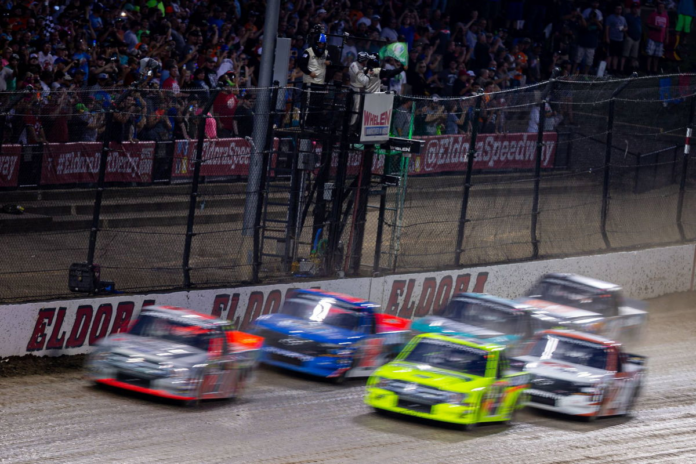NASCAR tracks often etch a memory in the heart of fans, much like drivers themselves do. One such track that has remained a source of awe for all and yet the fortune of the same proved to be short-lived is the Walt Disney World Speedway. This particular track combined the best of the two worlds – the excitement of an amusement park coupled with the high-speed thrill of a motorsport track.
The construction of the track dates back to the era of 1990s and that too under the guidance of Michael Eisner, who was the CEO of Disney. Despite the unique experience that it offered with its classic D shape, the track did not remain open long.
Walt Disney track – a wondrous track of its kind
ADVERTISEMENT Article continues below this ad
Now, one wouldn’t think that Walt Disney World would have slow seasons today. Back in the 1980s, this was the case, and during these periods of slow seasons, the park remained largely empty. The powers that be, at the time, thought having a big race during this period could help bring in more people. By 1994, survey work began taking place in secret, with the full-blown announcement coming in 1995. The track would be located at the south end of the Magic Kingdom Part 1, hosting the inaugural race of the Indy Race League.
The inception of the Walt Disney track was led in collaboration with Indianapolis Motor Speedway and Walt Disney Imagineering. It was in 1996 that the track was inaugurated as a part of the Indy Racing League (IRL) schedule. Miraculously enough, this has been one of the tracks in the history of NASCAR, which has been shaped after the letter D and an oval design. The choice of shape ensured that the track could fit very easily into the parking lot of the Magic Kingdom lot. This is exactly the reason why the track promised to be challenging for drivers.
The same year, the Speedway hosted the very first event, the Indy 200. Despite the strategic positioning and the live broadcast on ABC, a Disney-partnered network, there were major issues with the track. In fact, in a matter of a few days only, the problems started to surface. One of the major problems was the parking issue during race days. Ultimately, it ensured that fans had to park at Epcot and then travel back to the tracks. The only two times that NASCAR for the Craftsman Truck Series, they used the tracks were in 1997 and 1998. While Joe Ruttman had won the first one, it was Ron Hornaday Jr who claimed the next trophy.
via Imago NASCAR, Motorsport, USA Truck Series XPEL 225 Mar 25, 2023 Austin, Texas, USA NASCAR Craftsman Truck Series driver Hailie Deegan 13 goes into turn eleven at Circuit of the Americas. Austin Circuit of the Americas Texas USA, EDITORIAL USE ONLY PUBLICATIONxINxGERxSUIxAUTxONLY Copyright: xDanielxDunnx 20230325_tbs_da8_110
Adding to the issues, the early closure of the tracks also resulted from safety concerns. The track consistently contributed to high-profile accidents. One of the most infamous ones occurred in the 2000s. In preparation for the 2000 Indy Racing League (IRL) season, Sam Schmidt was behind the wheel during a testing session. However, in a split second, he lost complete control and ended up hitting the wall at a speed of 180 km/hr. This left him heavily injured. Schmidt suffered from a C3 and C4 injury that left him breathless for nearly four minutes.
ADVERTISEMENT Article continues below this ad
While this accident shook the foundation of the tracks from within, on inspection, it was found that there were major issues with the track. This included the absence of modern safety measures like SAFER barriers. The ultimate blow to the track’s fate culminated when there was major indecision about the scheduling of races which finally led to the removal of the track from calendars after the 2000s. The Walt Disney World Speedway remains a unique chapter in both Disney’s and motorsport’s history. While it does showcase the ambitions of the 1990s, it ultimately fell victim to logistical challenges, safety concerns, and shifting priorities.
How strategic was it to build the Walt Disney World Speedway?
The Walt Disney World Speedway is a circuit that spread for about 1.6 km, and despite the same it had only 16 km of safety restraint cabling and 5,200 tons of asphalt for the track surface. Consequently, it might be a common question that when the track shut down so fast, how strategic was it to build the same? From a business point of view, the track was a good investment as it required only 6 million. If put in comparison with the other tracks, the difference is huge.
ADVERTISEMENT Article continues below this ad
However, the lack of strategic planning and ensuring security measures soon backfired and led to the complete closure of the tracks. Given that this was Disney’s first venture into this world, it had kind of secured the feel of a magic land. It was also referred to as “The Mickyard”.
It was only functional for about 10 years and that too towards the end, it could not pull much of the crowds. During the closure of the track, it was announced formally that the track from now on would be used for “transportation improvements”. This hinted that the tracks could be used for parking as an extension for Disneyland.


